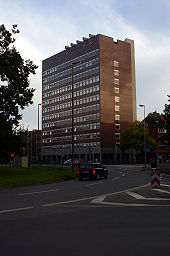Ludgeriplatz
The Ludgeriplatz is a square in Münster in Westphalia that is home to a two-lane roundabout .
location
It is located on the southern edge of Münster city center, directly on the promenade . The center of the square is a large, two-lane roundabout ("Ludgerikreisel"), which is one of the most important traffic junctions in Münster. A total of six streets lead to and from it, including the four main roads Moltkestrasse , Hammer Strasse , Hafenstrasse and Schorlemerstrasse . The street Am Kanonengraben runs parallel to the promenade, while the Ludgeristraße leads to the city center of Münster. Moltke Strasse and Hammer Strasse are also part of Bundesstrasse 54 .
history
The square is named after the Frisian missionary Liudger , who is considered the founder of the city. It is located on the site of the former Ludgeritor, a tower gate that was in the city fortifications between the end of the 12th century and 1785. The gate was so named because the St. Ludgeri church, which still exists today, is located on the inside of the city fortifications . It was additionally protected by a roundabout until 1654 . Since it was damaged by a landslide in 1652, it was replaced by a larger bastion from 1654 . Remnants of this defense system were discovered during renovation work in 2008. In 1876 the former fortification in front of the city gate was converted into a green area. The course of the road has been documented as unchanged since around the 1880s. A roundabout has been an important traffic junction at this point since 1936.
Special sights are the two bronze sculptures "Man with Horse" and "Maid with Bull" , which Rémy Zaugg returned to their original location in 1987 in the course of the Sculpture.Projects and which welcomed the rural population as early as 1912.
Traffic volume
The traffic volume is around 30,000 to 38,000 vehicles and 12,000 cyclists per day. Drivers mainly move in an east-west direction, while the majority of cyclists cross the roundabout in a north-south direction. A large number of bus routes go to the two stops at Ludgeriplatz.
Especially in the morning hours and in the evening rush hour, Ludgeriplatz is characterized by backwater to Weseler Straße and slow-moving traffic. All crossings of the adjacent streets are provided with zebra crossings. With a continuous flow of pedestrians, particularly in the vicinity of the two bus stops, a not inconsiderable backwater regularly forms at these for motorized road users. Therefore, citizens of Münster suggested controlling the flow of pedestrians with traffic lights so that the motorized flow of traffic within Ludgeriplatz does not come to a standstill.
Accident blackspot
The Ludgeriplatz roundabout is one of the hot spots for accidents in the city of Münster. Every year several cyclists are seriously injured in accidents with motor vehicles, three cyclists have been killed in the process. In order to reduce the risk of accidents, the roundabout was rebuilt in 2008. In addition, all access roads at the junctions with the roundabout are provided with stop signs.
In 2011, 14 cyclists were injured in accidents with motorists, the following year the number fell to 11 injured cyclists. In 2013 there were fewer traffic accidents in Münster than in the previous year. Nevertheless, there was sheet metal damage in the roundabout every third day, injuring 17 road users. As a result, Ludgeriplatz continues to be one of the three accident accumulation points in the city, along with Wolbecker Straße and Yorkring at the level of the Gasselstiege.
In order to get the traffic volume under control and at the same time to defuse Ludgeriplatz as a hotspot for accidents, suggestions for equalizing the traffic flows are regularly put forward. The Dutch Hovenring is seen as a model to separate cyclists from other traffic in order to achieve this goal.
Residents
There are three public, chargeable parking spaces at Ludgeriplatz. Townhouse 2 is located between Hammer Straße and Hafenstraße. The Münster University of Music is located between Schorlemerstraße and Ludgeristraße . Between the street Am Kanonengraben and the Moltkestrasse there is an office building in which the local branch of the ADAC was housed for years . This building, which has 4,300 square meters of usable space and an underground car park, was acquired by a Münster resident in October 2013 and is now to be renovated after it had previously belonged to a Luxembourg real estate fund for years.
Individual evidence
- ↑ a b c Landschaftsverband Westfalen-Lippe: Promenade, Münster in LWL-GeodatenKultur, accessed on March 13, 2014
- ↑ Plan of the city of Münster by A. Weiß from around 1880
- ↑ a b c d e f Westfälische Nachrichten : Floating roundabout for Leezen: Dutch traffic planners separate cars and bicycles / model for Ludgeriplatz? ( online ), Münster, Münster, Klaus Baumeister, February 15, 2014
- ^ A b Westfälische Nachrichten : Ludgerikreisel: traffic lights for pedestrians , Münster, letters to the editor, December 20, 2013
- ↑ a b c Westfälische Nachrichten : Münster will be safer - traffic balance 2013: Fewer injuries, fewer accidents / 1920 people were hit and missed ( online ), Münsterischer Anzeiger, Münster, Martin Kalitschke, February 18, 2014
- ↑ a b Westfälische Nachrichten : Change of ownership at Ludgeriplatz: Dominus company acquires 4300 square meter office building / renovation planned ( online ), Münster, Klaus Baumeister, October 25, 2013
Web links
Coordinates: 51 ° 57 ′ 21 ″ N , 7 ° 37 ′ 35 ″ E

